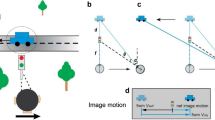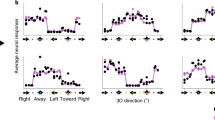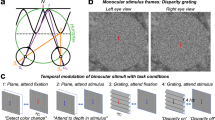Abstract
To achieve stereoscopic vision, the brain must search for corresponding image features on the two retinas1. As long as the eyes stay still, corresponding features are confined to narrow bands called epipolar lines2,3. But when the eyes change position, the epipolar lines migrate on the retinas4,5,6. To find the matching features, the brain must either search different retinal bands depending on current eye position, or search retina-fixed zones that are large enough to cover all usual locations of the epipolar lines. Here we show, using a new type of stereogram in which the depth image vanishes at certain gaze elevations, that the search zones are retina-fixed. This being the case, motor control acquires a crucial function in depth vision: we show that the eyes twist about their lines of sight in a way that reduces the motion of the epipolar lines, allowing stereopsis to get by with smaller search zones and thereby lightening its computational load.
This is a preview of subscription content, access via your institution
Access options
Subscribe to this journal
Receive 51 print issues and online access
$199.00 per year
only $3.90 per issue
Buy this article
- Purchase on Springer Link
- Instant access to full article PDF
Prices may be subject to local taxes which are calculated during checkout





Similar content being viewed by others
References
Julesz, B. Binocular depth perception of computer-generated patterns. Bell. Syst. Tech. J. 39, 1152–1162 (1960).
Ogle, K. Researches in Binocular Vision (Saunders, Philadelphia, 1950).
Rogers, B. J. & Bradshaw, M. F. Does the visual system use the epipolar constraint for matching binocular images? Invest. Ophthalmol. Vis. Sci. 37 (Suppl.), 31–25 (1996).
Stevenson S. B. & Schor, C. M. Human stereo matching is not restricted to epipolar lines. Vision Res. 37, 2717–2723 (1997).
Tweed, D. Visual-motor optimization in binocular control. Vision Res. 37, 1939–1951 (1997).
Gårding, J., Porrill, J., Mayhew, J. E. W. & Frisby, J. P. Stereopsis, vertical disparity and relief transformations. Vision Res. 35, 703–722 (1995).
Mok, D., Ro, A., Cadera, W., Crawford, J. D. & Vilis, T. Rotation of Listing's plane during vergence. Vision Res. 32, 2055–2064 (1992).
Van Rijn, L. J. & Van den Berg, A. V. Binocular eye orientation during fixations: Listing's law extended to include eye vergence. Vision Res. 33, 691–708 (1993).
Howard, I. P., Ohmi, M. & Sun, L. Cyclovergence: a comparison of objective and psychophysical measurements. Exp. Brain Res. 97, 349–355 (1993).
Hooge, I. Th. C. & van den Berg, A. V. Visually evoked cyclovergence and extended Listing's law. J. Neurophysiol. 83, 2757–2775 (2000).
Crone, R. A. & Everhard-Halm, Y. Optically induced eye torsion. Albrecht v. Graefes Arch. klin. exp. Ophthal. 195, 231–239 (1975).
Hooten, K., Myers, E., Worrall, R. & Stark, L. Cyclovergence: The motor response to cyclodisparity. Albrecht v. Graefes Arch. klin. exp. Ophthal. 210, 65–68 (1979).
Kertesz, A. E., Sullivan, M. J. The effect of stimulus size on human cyclofusional response. Vision Res. 18, 567–571 (1978).
Carpenter, R. H. S. The Movements of the Eyes (Pion, London, 1988).
Helmholtz, H. von. Handbuch der Physiologischen Optik (Voss, Hamburg, 1867).
Minken A. W. H. & Van Gisbergen, J. A. M. A three-dimensional analysis of vergence movements at various levels of elevation. Exp. Brain Res. 101, 331–345 (1994).
Allen, M. J. The dependence of cyclophoria on convergence, elevation and the system of axes. Am. J. Optom. 31, 297–307 (1954).
Kapoula, Z., Bernotas, M. & Haslwanter, T. Listing's plane rotation with convergence: role of disparity, accommodation, and depth perception. Exp. Brain Res. 126, 175–186 (1999).
Steffen, H., Walker, M. F. & Zee, D. S. Rotation of Listing's plane with convergence: independence from eye position. Invest. Ophthalmol. Vis. Sci. 41, 715–721 (2000).
Hepp, K. On Listing's law. Commun. Math. Phys. 132, 285–292 (1995).
Hepp, K. Theoretical explanations of Listing's law and their implication for binocular vision. Vision Res. 35, 3237–3241 (1995).
Farell, B. Two-dimensional matches from one-dimensional stimulus components in human stereopsis. Nature 395, 689–693 (1998).
Nielsen, K. R. & Poggio, T. Vertical image registration in stereopsis. Vision Res. 24, 1133–1140 (1984).
Prazdny, K. Vertical disparity tolerance in random-dot stereograms. Bull. Psychonom. Soc. 23, 413–414 (1985).
Robinson, D. A. A method of measuring eye movement using a scleral search coil in a magnetic field. IEEE Trans. Biomed. Eng. 10, 137–145 (1963).
Tweed, D., Cadera, W. & Vilis, T. Computing three-dimensional eye position quaternions and eye velocity from search coil signals. Vision Res. 30, 97–110 (1990).
Acknowledgements
We thank D. Henriques, I. Howard, E. Klier, P. Nguyen, J. Sharpe, H. Wang, A. Wong and J. Zacher for help with experiments; and K. Beykirch, P. Hallett, C. Hawkins, D. Henriques, H. Misslisch, M. Niemeier and T. Vilis for comments on the manuscript. This study was supported by the Canadian Institutes for Health Research and the Deutsche Forschungsgemeinschaft. D.C. is a CIHR Scholar and D.T. a CIHR Scientist.
Author information
Authors and Affiliations
Corresponding author
Rights and permissions
About this article
Cite this article
Schreiber, K., Crawford, J., Fetter, M. et al. The motor side of depth vision. Nature 410, 819–822 (2001). https://doi.org/10.1038/35071081
Received:
Accepted:
Issue Date:
DOI: https://doi.org/10.1038/35071081
This article is cited by
-
A dataset of stereoscopic images and ground-truth disparity mimicking human fixations in peripersonal space
Scientific Data (2017)
-
The Active Side of Stereopsis: Fixation Strategy and Adaptation to Natural Environments
Scientific Reports (2017)
-
A three dimensional view of stereopsis in dentistry
British Dental Journal (2015)
-
Stereo vision and strabismus
Eye (2015)
-
How efficient coding of binocular disparity statistics in the primary visual cortex influences eye rotation strategy
BMC Neuroscience (2013)
Comments
By submitting a comment you agree to abide by our Terms and Community Guidelines. If you find something abusive or that does not comply with our terms or guidelines please flag it as inappropriate.



